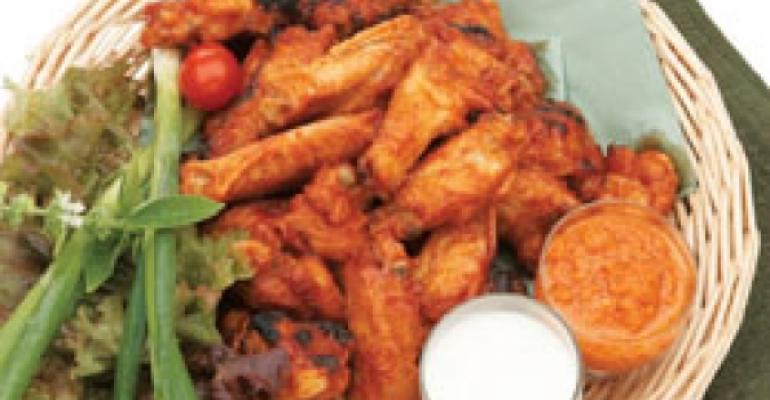After a year of profit-friendly reductions in commodity pricing for nearly everything but chicken wings, the cost of which has risen on high demand, many restaurateurs are bracing for a tougher purchasing environment in 2010, where little wiggle room will be available for even slight commodity inflation.
Though most restaurant chains project that their 2010 commodity costs are likely to either remain flat or increase slightly from 2009 levels, there is not as much leeway to react to increased costs, given that top lines remain stubbornly flat and consumers have little tolerance for menu price hikes. Even more, cost-cutting moves like menu re-engineering or supply chain efficiency building have already been completed, observers note.
“2010 will not be a good year for the industry,” said John T. Barone, president of Market Vision Inc., a consulting firm specializing in purchasing, and a contributing editor to Nation’s Restaurant News. “Most operators have done a lot this year to adjust their operations, and they are not sure what else they can do to squeeze more out.”
While Barone expects commodity cost escalation won’t be significant in 2010, he said even a slight increase could be enough to hurt restaurants that are just scraping by using reduced costs to offset reduced sales.
According to research from Market Vision, the costs of all proteins and dairy are expected to rise next year, with some growing by double digits from 2009. For example, pork is expected to increase 12.1 percent and butter is projected to increase 23.7 percent. In addition, a weak U.S. dollar will increase foreign demand for U.S. products, Barone said, and could further drive price increases late next year, especially for beef.
He noted, however, that these projections, based on U.S. Department of Agriculture figures and updated on Oct. 12, still show a decrease from prior-year, or 2008, levels.
At Chipotle Mexican Grill Inc., parent to the 900-unit Chipotle burrito chain, pressure on commodity costs is top of mind for next year. Company officials said they expect total commodity costs to increase in the low-single digits next year, as costs rise on meats and cheeses, but fall on produce, soy, rice and wheat. Whether the brand has the pricing power to offset that increase is questionable, executives said.
“The items that we buy the most of—and that would be our meats and cheese, in particular—there continues to be pressure on those items,” Chipotle’s chief financial officer John Hartung said during an October conference call with investors. “We’ve seen pressure—pressure on the business model, especially on the chicken, the beef and the pork, throughout this year, but there hasn’t been really the pricing power.”
Denver-based Chipotle, while one of few restaurant brands posting positive sales trends, took a 6-percent menu price increase at this time last year to help it shore up unit-level margins. For its latest quarter ended Sept. 30, margins rose 4.1 percent from a year ago to 25.5 percent. Officials noted that another menu price increase would be tough to implement in today’s environment of reduced consumer spending, but it has not been ruled out.
Chipotle is not alone. The ability for restaurant operations to raise prices in order to offset escalating costs is debatable at this juncture, said restaurant analyst Jeff Farmer at Jefferies & Co.
“Determining a restaurant concept’s pricing power is difficult, but we note that virtually every publicly traded restaurant concept is currently delivering negative traffic trends,” he said in a report last month. “Combine this with negative check trends over the last several months and it is clear that most restaurants have little, if any, pricing power.
“Our bottom line is that even if commodity costs are stable in 2010, restaurants have far less pricing power and will see far less [cost of goods sold] favorability,” he continued.
In 2009, earnings were driven by a favorable year-over-year cost environment, as companies cut corporate expenses and benefited from reduced commodity and operating costs compared to the spikes experienced in 2008. As those benefits fade, restaurants will need more than ever to drive performance improvements through increased sales, observers said.
“[Cost of goods] favorability has been the biggest driver of margin and earning-per-share upside in 2009, but our research suggests that a repeat performance is unlikely in 2010,” Farmer said.
In his analysis, Farmer looked at the commodity cost guidance from 35 publicly traded restaurant companies as well as the Oct. 14 prices for eight key commodities: chicken, cheese, corn, wheat, milk, beef, live cattle and butter.
At Buffalo Wild Wings Inc., a move to more margin-friendly menu items, like boneless wings made of breast meat, will help the company offset spiking chicken wing costs. In the September-ended third quarter, the cost of 1 pound of traditional chicken wings was 43-percent higher than it was a year ago, the company reported. Traditional bone-in chicken wings account for 21 percent of Buffalo Wild Wings’ sales. So far in the fourth quarter, chicken wing prices have spiked 39 percent from the same time last year.
The Minneapolis-based company, which operates or franchises the 633-unit chain, has promoted other items to help offset the traditional wing costs, such as boneless wings; “Wild Flatbreads,” which are flatbreads topped with varying flavors of chicken, sauce and cheese; and “Slammers,” or bite-sized sandwiches.
“As our results to date this year attest, the significance of the volatility in [chicken wing] cost and the importance of isolating this factor continues to lose relevance,” said Buffalo Wild Wings chief financial officer Mary Twinem. “For the first nine months of 2009, the cost of traditional wings has been substantially higher than prior years, yet we have improved restaurant-level performance and should achieve our net earnings growth goal for the year.”
The company also will explore a menu price increase when it begins its new menu rollout in the first quarter, she said.— [email protected]




